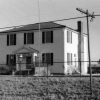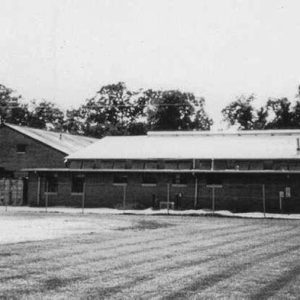calsfoundation@cals.org
Piggott National Guard Armory
The Piggott National Guard Armory at 775 East Main Street in Piggott (Clay County) was built in 1956 and reflects the “Type ‘Z-Z’ one unit” design developed by the Wittenberg, Delony & Davidson architectural firm of Little Rock (Pulaski County).
Citizen-soldier militias have had a constant presence in the United States since the colonial era, but it was not until Congress passed the Militia Act of 1903—also known as the Dick Act for sponsor Senator Charles W. F. Dick, chairman of the Committee on the Militia—that the National Guard became an official partner in the nation’s armed services, receiving federal support for training, equipment, and wages. Arkansas’s state militia was organized into the Arkansas National Guard as a result of the Dick Act.
Seventeen Arkansas National Guard armories were built through a program authorized by Act 271 of 1925, which created a “Military Fund” for building armories, and many others were constructed during the Great Depression through such New Deal agencies as the Works Progress Administration (WPA). During the Cold War era, Congress passed the National Defense Facilities Act of 1950, which appropriated money for renovation and erection of Reserve Armed Forces facilities, including some in Arkansas. In 1952, Brigadier General John B. Morris Jr. estimated that Arkansas’s armory needs totaled $3,705,000. The U.S. government would provide $2,778,750, while the State of Arkansas was to contribute $926,250.
Many of the Arkansas armories were designed by the Little Rock architectural firm Wittenberg, Delony & Davidson, which developed the “Type ‘Z-Z’ one unit” plan, in which office space, restrooms, storage, and kitchens were built one story high, with concrete block and brick veneer and a flat roof. Drill halls were built with a two-story-high steel frame topped by a gable roof with several awning windows on each side.
Before the Piggott National Guard Armory was built in 1956, Battery C of the 445th Field Artillery Battalion was based in a rented armory. Captain Iverson C. Cameron of the 445th wrote to Guard officials in Little Rock on June 17, 1949, that “the state does have a Deed to a lot here in Piggott [on] which it expected that bldgs. will be constructed on, for use of the Arkansas National Guard.” The lot was 150 by 200 feet and valued at about $1,000, according to Cameron.
On December 30, 1955, the Piggott Banner published a letter from U.S. Congressman E. C. “Took” Gathings saying that “the Armed Services Committee approved the Piggott armory project with federal funds estimated in the neighborhood of $37,500.” In the same issue, theBannermade the editorial note: “This means to get the armory, Piggott will have to raise the amount of $12,500 to $14,000 to construct the type of building designed.” That goal was met, the newspaper reported on January 13, 1956, after the city board voted to allocate money from City Light and Water Fund revenues to build the new armory for Battery C, 709th Field Artillery. The Piggott armory housed the firing unit of Battery C, an eight-inch howitzer unit. The battery’s headquarters unit, based in Paragould (Greene County), also would get a new arsenal in 1956; the battery’s service unit was based in Wynne (Cross County). The Piggott National Guard Armory also has housed elements of the 142nd Field Artillery, 218th Medical Ambulance Company, 153rd Infantry Regiment, and 875th Engineering Battalion.
The Piggott Banner wrote on January 27 that “the military department already has adopted plans and specifications for the steel and concrete structure similar to the new armory recently completed” in Brinkley (Monroe County). Cox Lumber Co. made the low bid for the project at $40,688; the heating and plumbing subcontractor was Clemson Brothers of Wynne. The structure was to be eighty-eight feet by ninety-six feet with a seventy-foot-by-eighty-foot auditorium. Construction was either underway or completed by August 10, when the Banner reported that an 81,000-pound, 155-millimeter self-propelled gun had been delivered via flatcar and was being moved to the armory.
On June 28, 2005, it was announced that five Arkansas National Guard armories would be closed, including the one at Piggott, as part of a major restructuring of the Guard. The City of Piggott received the arsenal and sold it to the Piggott School District —which uses it for storage—in 2010.
The Piggott National Guard Armory was listed on the National Register of Historic Places on May 31, 2006.
For additional information:
“AMD to Ask Bids on New Armory.” Piggott Banner, January 27, 1956, p. 1.
“Armory Funds are Assured.” Piggott Banner, January 13, 1956, p. 1.
Burns & McDonnell Engineering Co., Inc. and Historical and Architectural Research, LLC. Army National Guard: Draft Final Historic Context Study, December 2004. Kansas City, MO: Burns & McDonnell and Historical and Architectural Research, December 2004.
“Contract Signed for New Armory.” Piggott Banner, March 9, 1956, p. 1.
“Five Guard Armories in Delta to Shut in Army Restructuring.” Arkansas Democrat-Gazette, June 29, 2005, p. 1A.
“Piggott Armory Receives Approval.” Piggott Banner, December 30, 1955, p. 1.
“Piggott National Guard Armory.” National Register of Historic Places nomination form. On file at Arkansas Historic Preservation Program, Little Rock, Arkansas. Online at http://www.arkansaspreservation.com/National-Register-Listings/PDF/CY0065.nr.pdf (accessed October 12, 2021).
URS Group, Inc. Arkansas Army National Guard Intensive Historic Research and Context. Gaithersburg, MD: URS Group, February 2005.
URS Corporation, Inc. Historic Structures Reconnaissance Survey of 14 Arkansas National Guard Armory and Vehicle Storage Shed Facilities. Little Rock: 2004.
Mark K. Christ
Arkansas Historic Preservation Program
 Architectural Styles
Architectural Styles Historic Preservation
Historic Preservation Military
Military World War II through the Faubus Era, 1941 through 1967
World War II through the Faubus Era, 1941 through 1967 Piggott National Guard Armory
Piggott National Guard Armory 




Comments
No comments on this entry yet.